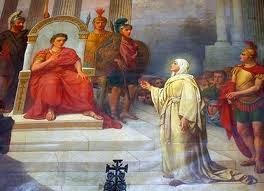 Mary Magdalene is my favorite woman of the Bible. She, courageous and steadfast, should have been the first pope instead of Peter. The legend of Magdalene and her visit to the Roman Emperor Tiberius is the source of the tradition of coloring Easter eggs. As it turns out, there may be at least a grain of historical truth to that story.
Mary Magdalene is my favorite woman of the Bible. She, courageous and steadfast, should have been the first pope instead of Peter. The legend of Magdalene and her visit to the Roman Emperor Tiberius is the source of the tradition of coloring Easter eggs. As it turns out, there may be at least a grain of historical truth to that story.
It is known that Mary of Migdal was a wealthy woman. That she had a title, unlike most women of her day, shows that she was an important person. I’ve been to her home town of Migdal, right near Capharnaum on the Sea of Galilee. Until the Romans obliterated it in the brutal war of revolt around 70 A.D., Migdal was a prosperous town renowned for its dried fish. The local fishing entrepreneurs sold dried fish to places as far away as Damascus. Mary was probably a fish-monger.
Migdal’s recent archaeological excavations revealed a synagogue that quite probably was the place where Jesus launched his public career. Mary became one of his loyal followers. In all likelihood she contributed some of her considerable wealth in support of his preaching and ministry. And who knows? They may have traveled together and been extremely good friends.
When the Romans crucified Jesus, all of the apostles fled the scene. Not his mother Mary, and not Mary Magdalene either. Legend has it that Magdalene was the first person Christ appeared to after his Resurrection. She ran to tell the apostles that she had seen the Lord. They didn’t believe her until they ran to the tomb themselves. She was a believer; they had to be convinced.
Though it is not officially chronicled anywhere, the story goes that Mary Magdalene stayed around and was a leader of the followers of Jesus in the dark and difficult early years after his death. And here’s where some of the possible historical truth mixed with the legend comes in.
First, the legend. Because she was a wealthy woman, she was able to get an audience with the Roman emperor Tiberius. She supposedly went to him to denounce Pontius Pilate for being so cruel at the trial of Jesus. At that audience, she also said that Christ rose from the dead and that she had seen Him.
She held out an egg to the emperor and said “Christ is Risen!” To which Tiberius replied that there was as much chance of a human being returning to life from the dead as there was of the egg in her hand turning red. And the egg promptly turned red!

Interior of the Church of Saint Mary Magdalene. The canvas with painting of Mary and Roman Emperor Tiberius hangs above the iconostasis.
That’s a nice story, and that’s why we have colored Easter eggs. But here’s the grain or strand of potential truth. The Jews of Palestine did send word to Rome that Pontius Pilate was a thoroughly bad guy and that they would not put up with him as governor any more. They may have threatened to revolt. But whatever they said worked. Tiberius agreed that that trial was unlawfully conducted. Pilate was fired from his job and soon disappeared from history.
Somebody had to carry the message or lead the delegation. It could have been Mary of Migdal, the richest woman in town.
Many icons painted in the Byzantine Catholic style show Mary Magdalene holding a red egg. So too does the canvas above the iconostasis in the Church of Saint Mary Magdalene, on the slope of the Mount of Olives in the Garden of Gethsemane. The iconostasis, in Eastern Orthodox churches, separates the nave from the sanctuary. The canvas shows Magdalene in the court of Tiberius. In her hand she holds a red egg.
I’ve been to Jerusalem twice, and both times the Church of Saint Mary Magdalene was closed to the public. I’m sorry that I didn’t have a chance to go inside. The church is unmistakably Russian, built in the Muscovite style with golden onion domes.
It was built as a memorial to Empress Maria Alexandrovna by her son, Czar Alexander III and his brothers. Grand-Duke Sergei Alexandrovich, brother of Alexander III, and his wife Grand Duchess Elizabeth (Princess Elizabeth of Hesse-Darmstadt), grand-daughter of Queen Victoria and sister of the last Empress of Russia, presided at the consecration of the church in 1888 as representatives of the Emperor.
Grand Duchess Elizabeth and commissioned the Russian artist Sergei Ivanov (1864-1910) to paint large murals depicting the life of Mary Magdalene. They were brought to Jerusalem for the consecration and hang in the church today. The painting with Magdalene, Tiberius, and the red egg is just one of them.
And there you have it. Mary Magdalene, the courageous and wealthy woman who should have been the Catholic Church’s first pope, gave us one of the best examples ever of steadfastness and loyalty. She also gave us the Easter egg.




